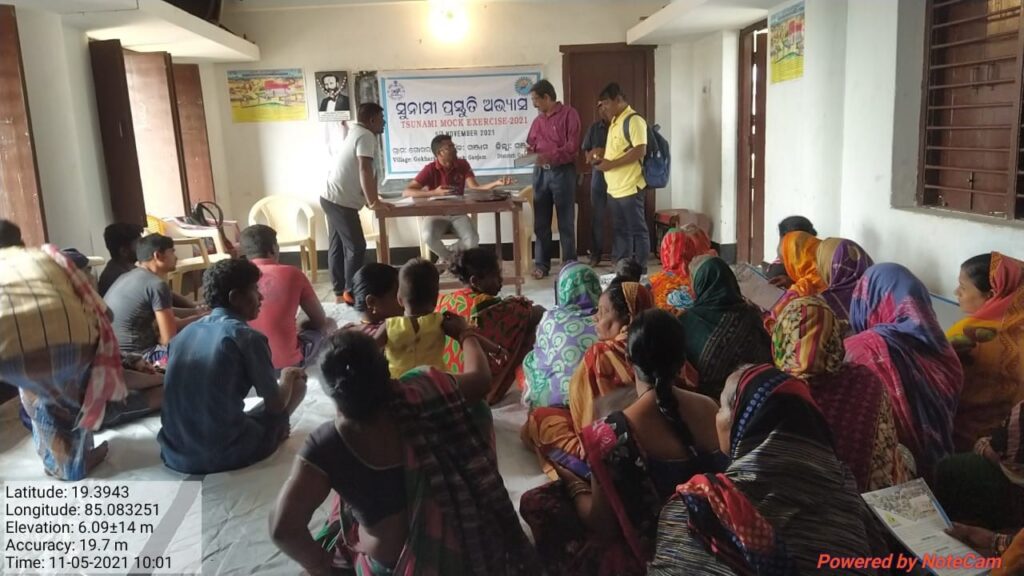The Indian Ocean tsunami of 2004 claimed around 10,000 lives in India and around 2,30,000 in surrounding countries. Though rare, this one event has shown the whole world how disastrous tsunami can be. The major reason for the great loss in the Indian Ocean was lack of knowledge, observation networks and operating procedures to detect and monitor the tsunamis. Fortunately, Govt. of India was the first one to step forward and took a great initiative to establish “Tsunami Early Warning Centre” at Indian National Centre for Ocean Information Services (INCOIS), the first state-of-the-art warning centre in the Indian Ocean countries.
Since 2004 tremendous developments have been made in tsunami science and India has been improving its services adopting advances in science and technology. The Indian Tsunami Early Warning Centre (ITEWC) not only acts as national warning centre, but also as a “Tsunami Service Provider” responsible to provide services to all Indian Ocean Member States under the framework of UNESCO’s the Intergovernmental Coordination Group for the Indian Ocean Tsunami Warning and Mitigation System (ICG/IOTWMS).
Though the tsunami services have been improving through several initiatives, we are still facing challenges in limited observation networks, limited knowledge on tsunami risk, inadequate community response. The recent tsunamis of Indonesia in 2018 brought us another challenge of tsunamis that are triggered by other than earthquakes such as submarine landslides and volcanic eruptions which can wash away the near-source regions within a few minutes.
It should be noticed that from the history of past tsunamis, many causalities occurred not just by the factor of tsunami itself but also due to lack of knowledge and wisdom of the signs of tsunami in the communities This lack of awareness and preparedness by the local communities and the officials led to slow responsiveness by us towards tsunami and need to be addressed.
In December 2015, the United Nations designated November 5 as World Tsunami Awareness Day. Japan proposed this date, in honor of a true story from Japan: “Inamura-no-hi”, which means the “burning of the rice sheaves”. A villager from Japan noticed approaching disastrous tsunami resulted from major earthquake on 5 November 1854 and guided his fellow villagers to evacuate to higher ground by setting fire to his precious sheaves of rice, as a signal of warning. The World Tsunami Awareness Day is intended to serve to protect the precious lives of people, and thus it should be associated with an example of “traditional, indigenous and local knowledge and practices”.
The Sendai Framework highlights the need for improved understanding of disaster risk in all its dimensions of exposure, vulnerability and hazard characteristics; the strengthening of disaster risk governance, including national platforms. On par with such framework, in order to create awareness about tsunamis in general public, school children and disaster management community, INCOIS has been organizing many national & international workshops, trainings and seminars. Easily understandable publicity material on earthquakes and tsunamis in vernacular languages has been created and distributed to the general public. In 2021, World Tsunami Awareness Day promotes “Sendai Seven Campaign,” target (f), which aims to ‘substantially enhance international cooperation to developing countries through adequate and sustainable support to complement their national actions for implementation of the present Framework by 2030.’
In India, as part of the 6th World Tsunami Awareness Day (WTAD) on 5 November 2021, INCOIS conducted the following programmes:
(1) A tsunami mock drill in coordination with Odisha State Disaster Management Authority (OSDMA) and Odisha State Emergency Operation Centre wherein INCOIS issued bulletins to Odisha stakeholders for evaluating their SOPs and Communication media. As part of mock drill ITEWC has simulated tsunami for an earthquake of M9.2 at Andaman & Nicobar Islands .A total of 69 coastal communities/wards actively participated and evacuated during tsunami mock drill to test the tsunami ready indicators.
(2) To improve the awareness on tsunami among school children, a visit was organized for 70 students of Bhashyam School to Warning Centre to understand the services. Tsunami Awareness material distributed to School children
(3) Science Teachers of Zilla Parishad High School from Bachupally visited INCOIS and had detailed discussions with INCOIS Scientists, as part of WTAD and Azad Ka Amrut Mahotsav
(4) A sensitization webinar on Tsunami Early Warnings and Tsunami Ready Programme was conducted to Andhra Pradesh State Disaster Management Authority (APSDMA) Officials.
(5) Also, ITEWC participated in a webinar on “Advances in Tsunami Sciences and its Disaster Risk Reduction” conducted by National Institute of Disaster Management (NIDM).
On this occasion Dr. T. Srinivasa Kumar, Director, INCOIS said “Though tsunami science has been going through several important development, it is equally important to strengthen downstream part, which we are taking as a challenge”
He also said that the recent recognition of two villages of Odisha (Venkatraipur and Noliasahi) as “Tsunami Ready” is just the beginning. INCOIS is putting more efforts to make all vulnerable communities as tsunami resilient communities through Tsunami Ready programme in collaboration with the state disaster management authorities.
Tsunami Warning System’s primary goal for the next decade is to emphasize and promote tsunami awareness and education for the coastal population and to enhance community resilience. This education and outreach program promotes hazard understanding and awareness, and offers tools and information resources to guide preparedness and response. This will be met by making the development of science & technology at scientific organizations go hand in hand with the community preparedness & response.
We cannot control the occurrence of an earthquake even with state-of-arts technologies. However, we can definitely mitigate the possible disaster by taking adequate measures by improving community awareness and preparedness, like “people must be aware how to respond to them, either natural warnings (signs) or official”.



